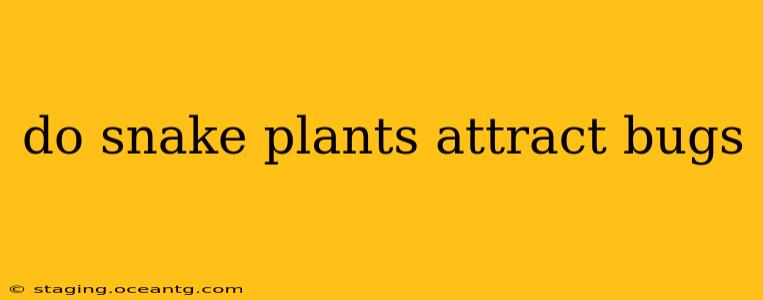Do Snake Plants Attract Bugs? A Deep Dive into Plant-Pest Relationships
Snake plants, known for their air-purifying qualities and low-maintenance nature, are popular houseplants. However, a common question among plant owners is whether these resilient plants attract bugs. The short answer is: generally, no, snake plants do not attract bugs more than other houseplants. In fact, they're often considered relatively pest-resistant. However, certain conditions can make them susceptible.
Let's delve deeper into the specifics and address some common concerns.
What Bugs Might Infest a Snake Plant?
While snake plants aren't magnets for pests, they can still be affected by common houseplant infestations. These include:
- Mealybugs: These small, white, cottony insects are a common houseplant pest. They suck sap from the plant, causing yellowing and stunted growth. Their presence is easily identifiable by the white, fluffy masses they leave behind.
- Spider mites: These tiny pests are difficult to see with the naked eye, but their webbing is a telltale sign. They also suck plant sap, leading to yellowing and discoloration. Look closely for fine webbing, particularly on the undersides of leaves.
- Scale insects: These small, immobile insects attach themselves to the plant's stems and leaves. They're often covered in a hard shell, making them difficult to remove.
It's important to note that these pests aren't attracted to snake plants specifically; they're opportunistic pests that can infest any weakened or neglected plant.
Why Might My Snake Plant Have Bugs?
Several factors can increase the likelihood of a snake plant infestation:
- Poor air circulation: Stagnant air can create a favorable environment for pests to thrive. Ensure adequate airflow around your snake plant.
- Infested nearby plants: If you have other plants infested with pests, they can easily spread to your snake plant. Regularly inspect all your plants for signs of infestation.
- Dry conditions: Extremely dry conditions can weaken the plant, making it more vulnerable to pests. Maintain adequate moisture levels, but avoid overwatering.
- Introduction of pests from outside: Pests can be brought in from outside on clothing, tools, or new plants. Inspect new plants thoroughly before introducing them to your existing collection.
How Can I Prevent Bugs on My Snake Plant?
Prevention is key! Here are some tips to minimize the risk of pest infestations:
- Regular inspection: Regularly check your snake plant for any signs of pests. Early detection is crucial for effective treatment.
- Proper watering: Water your snake plant deeply but infrequently, allowing the soil to dry out between waterings. Avoid overwatering, which can lead to root rot and weaken the plant.
- Good air circulation: Ensure adequate airflow around your plant to prevent stagnant air.
- Quarantine new plants: Isolate new plants for a few weeks to observe for any pests before introducing them to your existing collection.
- Cleanliness: Keep the surrounding area clean and free of debris to discourage pest activity.
Do Snake Plants Repel Bugs?
While snake plants don't actively repel insects like some other plants (e.g., certain herbs), they aren't particularly attractive to them either. Their tough, waxy leaves make them relatively resistant to many common pests.
What to do if I find bugs on my snake plant?
If you discover pests on your snake plant, act quickly. Isolate the affected plant to prevent the spread of infestation. For minor infestations, you might be able to remove pests manually with a cotton swab dipped in rubbing alcohol. For more severe infestations, consider using insecticidal soap or neem oil. Always follow the product instructions carefully.
By following these preventive measures and addressing any infestations promptly, you can keep your snake plant healthy and pest-free, ensuring it continues to thrive in your home.
